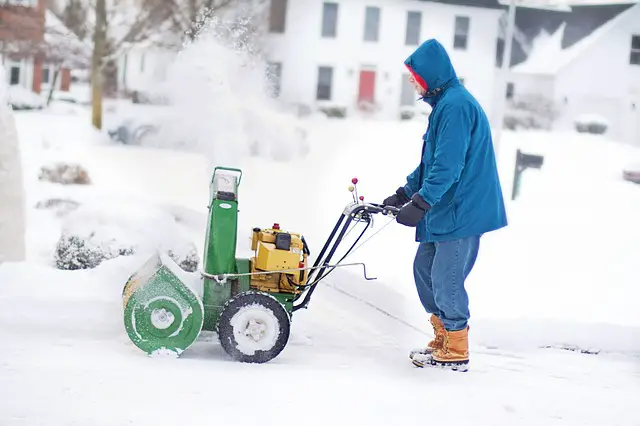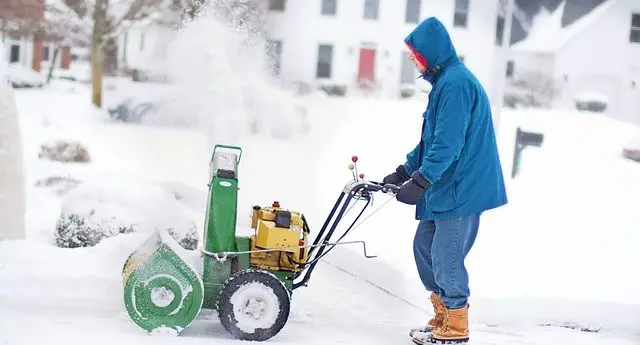Snowblowers require oil to continue operating seamlessly during the winter season. Ensuring regular oil change is essential, but it’s even more vital that you choose the right oil for your Craftsman snowblower. It’s a fact that brand matters when you’re selecting the right oil type for your machine. While some snowblower machines accept synthetic oil, others only promote natural oil on the snowblower machine. To determine what the best Craftsman snowblower oil type is, keep reading. At the end of this article, you’ll discover:
- What oil type is ideal for your Craftsman snowblower?
- How to break in your new Craftsman snowblower
- How to check and change the oil in your Craftsman snowblower
Now that you know what to expect, let’s begin.
Contents
What Oil Type is Ideal For Your Craftsman Snowblower?
The right oil type for your snowblower entirely depends on the temperature in your region. The user manual also recommends the right oil weight for you to go for. When the temperature falls beneath 0 degrees Fahrenheit, the right weight oil for Craftsman snowblower is 5W30.
The next consideration in determining the best Craftsman snowblower oil type is whether the oil is natural or synthetic. Suppose you live in a region where the temperature increases and decreases spontaneously; this is vital. In such situations, the user manual suggests that users settle for a DW30 synthetic oil.
This choice of oil type is ideal for both temperatures -40 degrees and over 0 degrees Fahrenheit. The best Craftsman Snowblower oil type befitting this temperature is SAE 5W30 oil.

How to Break in Your New Craftsman Snowblower
When you purchase a new Craftsman Snowblower, you have to break it in to ensure that the snowblower performs excellently. One way to break in your new Craftsman snowblower is through an oil change. The Craftsman owner’s manual suggests that you only put in enough oil for hours of work.
After a few hours of use, carry out an oil change after a few hours. Doing this will help flush out contaminants and dust in the machine. These factors are common with new engines, and with the oil change, your engine will be ready for use.
How to Check and Change the Oil in Your Craftsman Snowblower
To prevent damage to your engine, you should maintain the right quality and amount of oil in your machine. Find out below how to check and change the oil in your Craftsman snowblower.
Checking the Oil
- Firstly, take off the oil filler cap and the oil dipstick; wipe the dipstick clean.
- Next, insert the dipstick into the fuel neck without securing the cap.
- Take out the snowblower oil dipstick and check the oil level. If it’s below the recommended level, add more oil till it is on the right level.
- Then replace the cap and dipstick before tightening the cap.
Changing the Oil
To change the oil, ensure you run the engine till the fuel tank is empty. Also, you need to ensure that the filling cap is secure and tightened. Now, follow the steps below to change the oil.
- To begin, place a container that can hold oil beneath the oil draining plug and remove the plug.
- Next, tilt your snowblower in the container’s direction so the oil can drain into it.
- Once it drains completely, dispose of the oil properly.
- Next, plug in the oil draining port.
- Afterwards, refill with the appropriate Craftsman snowblower oil type. The ideal choice would be the SAE 5W-30
- Once you’re done refilling, secure the oil dipstick and filler cap.
- How to Get Potatoes to Sprout Eyes: Detailed Growing Guide with 3 Options - July 31, 2023
- Weight of a Medium Potato: Revealed in Detailed Guide - July 29, 2023
- Maris Piper Potatoes: 9 Substitutes You Should Know About - July 27, 2023
Hello! I’m Jessica Zander, a garden coach and consultant based in the Boston area (zone 6b), offering virtual consultations across the country and Canada.
I’ve been passionate about gardening since the early 1990s, and in 2022, I launched You Can Do It Gardening to empower individuals to feel more confident in their gardening endeavors.
Following a 30-year career in nonprofit finance and operations, I transitioned out of that field in mid-June of 2023 due to the growing demand for coaching services. Interestingly, my years of presenting financial statements to boards and finance committees proved to be valuable experience for teaching people about gardening! I enjoy sharing skills, providing guidance and suggestions, and collaborating efficiently with clients to make significant improvements to their outdoor spaces, both small and large. I also regularly teach at the Arlington Continuing Education and Cambridge Adult Education.
My approach is direct and practical, akin to Mary Poppins, but tailored to your garden. Clients find satisfaction in saving money and taking pride in their own gardening achievements.


Add comment